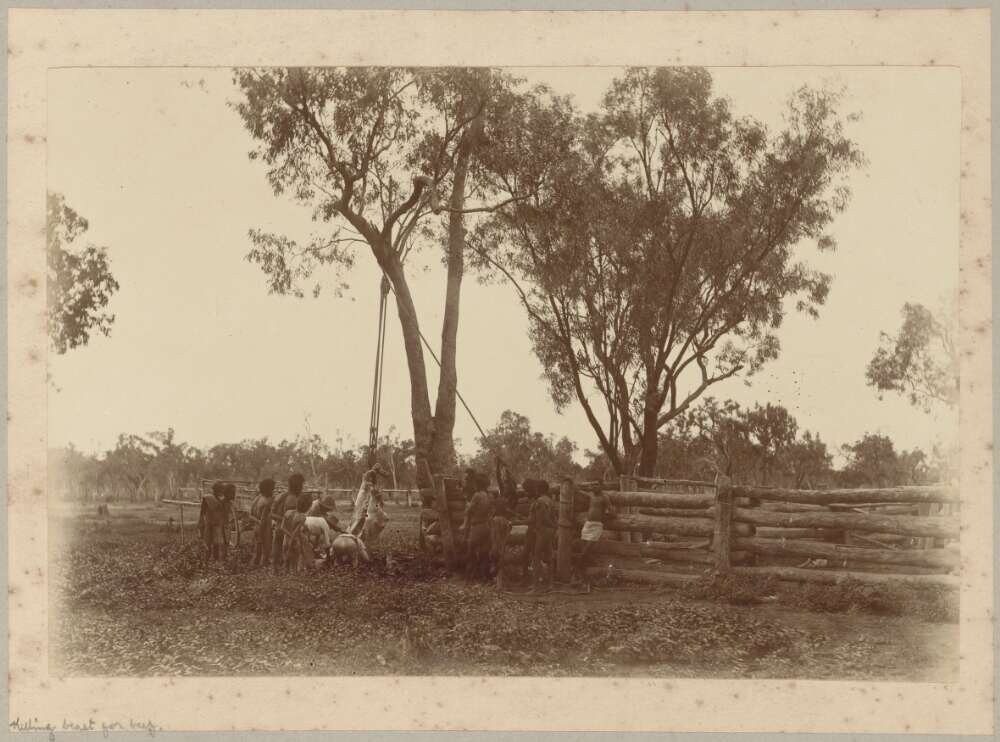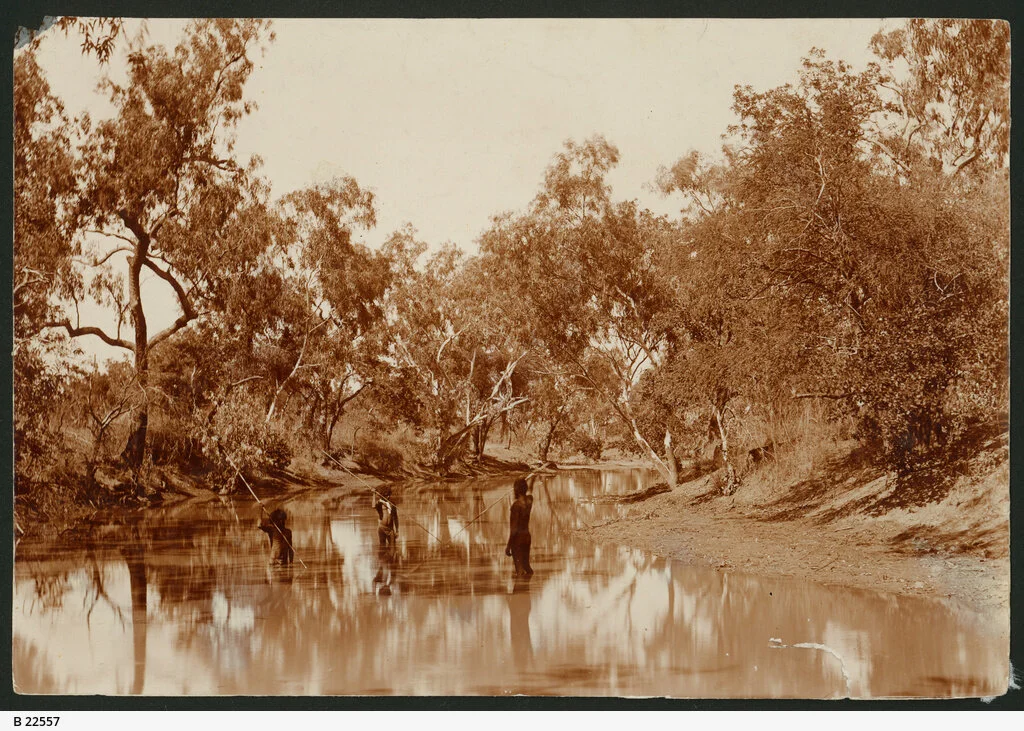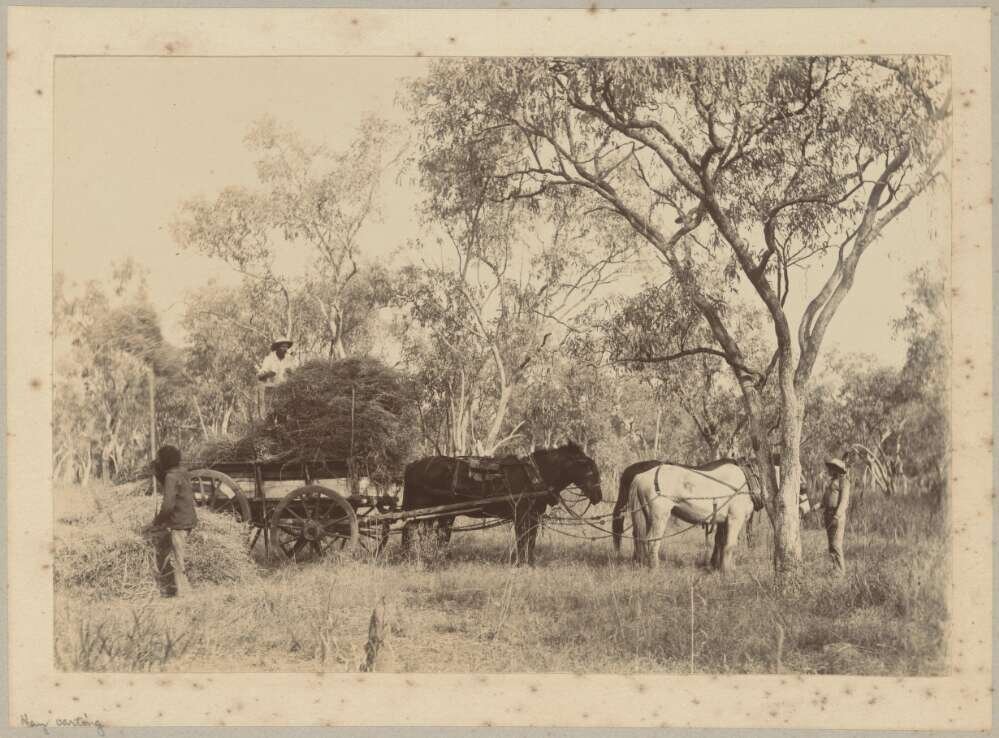Daly Waters History; Aboriginal Peoples
Daly Waters line party's camp.
State Library of South Australia; Daly Waters [B0-2256] • Photograph 1895
Daly Waters
Today Daly Waters is renowned for its pub. This quirky bar with its accommodation and camping entices travellers off the Stuart Highway with the promise of a unique pub experience. If the truth be told it is fairly unique. However, few who venture in for a pint are truly aware of the history that engulfs Daly Waters. How many pubs in Australia can boast of having two of the previous owners publish books about their experiences as landlords? How about an article published in a peer-review journal looking at why people visit this pub? By exploring the history of Daly Waters, you get a sense of how the “colonial” Northern Territory developed.
John McDouall Stuart. Successful expedition across the continent of Australia. (1861-1862)
The Overland Telegraph. Linking Adelaide to Darwin and then to the rest of the world. (1870 – 1872)
Stock Routes. Movement of vast herds of Cattle from the southern states in the NT and the Kimberly. (1883)
Daly Store and Pub. (1930)
Air Service, Australia’s link to Asia and Europe. (1930)
World War Two. (1942)
In the next few articles on Daly Waters, we explore this history in an attempt to shed more on Daly Waters, its pub, and some of the characters that have called it home.
Aboriginal Peoples in the Daly Waters Region
Very little information regarding Daly Waters before Stuarts expedition can be found on the internet. What you do find seems to be a cycle of copy and paste of the same information exacerbated by the lack of any additional new information.
What do we know?
Local knowledge about conditions was important for white settlers, especially in isolated regions. As mentioned above, there had been long-term relations between the white settlers at Daly Waters and the Yangman and the Jingili people. (1)
From the above, we can then assume Daly Waters was frequented by both the Yangman and the Jingili people.
The Jingili people.
This region lies in the central section of the Barkly District, it centres around Elliott and Newcastle Waters and encompasses outlying areas of Daly Waters to the north and Renner Springs to the South. This region is home to Jingili, Mudburra, Walmanpa people. (2)
The Yangman people.
In Tindale's estimation, the Yangman's territory extended over some 5,600 square miles (15,000 km2) covering the plateau terrain lying between the Roper and Victoria river systems. Its southern reaches extended to Elsey Creek, south of Mataranka, especially around Warlock Ponds, as far as Daly Waters. (3)
Once again from the above, it would suggest that Daly Waters lies in the transitional or border zone between the Jingili and Yangman nations. Is it safe to assume that due to its locality in a border region Daly Waters may not have been well frequented by these nations?
Aboriginal and/or Torres Strait Islander peoples should be aware that this publication on the history of Daly Waters contain the images of people who have passed away. Images from earlier eras reflect the attitudes of the times and might cause offence in today's society. Care and discretion should be used when viewing the items.
The following buttons show images of early Jingili people.
Our first written account documenting encounters (or lack of encounters) with Aboriginal people in the Daly Waters area comes from the journal of John McDouall Stuart in his successful expedition across the continent of Australia. (1861-1862) Extracts from the journal are as follows:
Wednesday, 28th May, Daly Waters, Fourth Chain of Ponds and Creeks. Sent Thring and King to round the swamp into which this creek flows. Observing some native smoke to the north-east, they returned (to camp). (4)
The next entry is on the trip back south after reaching the north coast of Australia.
Monday, 25th August, Purdie Ponds. Started at seven o’clock on my former tracks towards Daly Waters. The natives have been running our tracks and have burnt the grass on both sides of it for some distance. There seem to be very few of them about this part of the country. (4)
After this documentation in Stuart's journal, very little additional written information regarding Aboriginal people is available. However, photographs taken at Daly Waters in the mid-1880s show Aboriginal men working in the area. At the very least this indicated a working relationship between the white settlers at Daly Waters and the Yangman and the Jingili people.
My Shout at the Daly Waters Pub. (By Mark Venable) First published 2017. Has the following to say regarding the early history at Daly Waters in his book.
According to locals, Daly Waters never hosted a permanent aboriginal population but there is plenty of evidence of temporary camps near the Daly Waters Lagoon and further upstream on the Daly Creek at the beautiful horseshoe waterfall, with its permanent waterhole in the rocks. It is said the aboriginals avoided this area as it is inhabited by aboriginal executioner spirit, the Kurdaitcha Man (sometimes known as the feather-foot man). Several aboriginals told me the tribes in the region only used the Daly Waters as a temporary resting place, so as not to upset the bad spirit. (5)
If you have done any research online regarding the early history of Daly Waters, then you will undoubtedly come across the following:
Daly Waters - The area’s traditional Aboriginal owners, the Jingili people, believe the Dreaming tracks of the Emu and the Sun travelled through here on their way to the southern parts of the Northern Territory. This phrase gets copied and pasted from one site to the next and is repeated and repeated and repeated. This is the full extent of the text and no elaboration is made. I could find no verification or source to this statement.
However, a possible source may be from the Barkly Regional Council’s website where the town of Elliott is featured. Extracts from this site are as follows: The traditional name for the township of Elliott is Kulumindini. It is the country of the Jingili desert people. The lands around Elliott lie across the important Dreaming tracks of the Emu and the Sun, spirit ancestors who were travelling through the country on their way to the southern parts of the Northern Territory. (6) If this applies to Daly Waters or if it was just lifted from the above site dues to its association with the Jingili people is unclear.
As a final note
The traditional owners of the Daly Waters area became the fourth Indigenous group in the Northern Territory to gain native title over both the townsite (Daly Waters) and ten surrounding pastoral leases covering an area of 30,000 square km. (7)References
Clearing Country and Opening the Skies: Aboriginal Workers and the Australian Aviation Industry. Prudence Black (1)
Protecting Sacred Sites Across the Territory. Barkly Central. https://www.aapant.org.au/sacred-sites/sacred-sites-nt/barkly-central
Wikipedia contributors. (2020, December 15). Yangman. In Wikipedia, The Free Encyclopedia. Retrieved 22:22, February 16, 2021, from https://en.wikipedia.org/w/index.php?title=Yangman&oldid=994340964
John McDouall Stuart Society. Expedition six. Webpage. http://johnmcdouallstuart.org.au/729-2
My Shout at the Daly Waters Pub. (By Mark Venable) First published 2017.
Barkly Regional Council. Elliott & LA Meetings. Website. https://www.barkly.nt.gov.au/communities/elliott
Wikipedia contributors. (2021, February 12). Daly Waters, Northern Territory. In Wikipedia, The Free Encyclopedia. Retrieved 09:50, February 17, 2021, from https://en.wikipedia.org/w/index.php?title=Daly_Waters,_Northern_Territory&oldid=1006441952

![Daly Waters line party's camp. State Library of South Australia; Daly Waters [B0-2256] • Photograph 1895](https://images.squarespace-cdn.com/content/v1/5fa76fe6f59e260b96ba1103/1613478614672-YYC1R4AG67XH541HBKWH/B-22560.jpeg)



